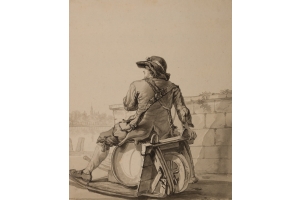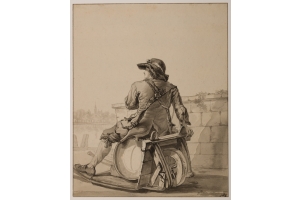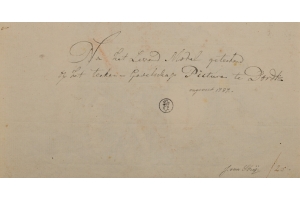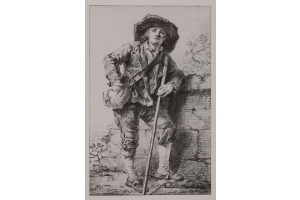



Jacob van Strij (Dordrecht, 1756-1815) was taught the basics of painting in the workshop of his father Leendert van Strij (Dordrecht, 1728-1798) and later went to Antwerp to become an apprentice of Andries Lens (Antwerp, 1739-Brussels, 1822). He was a well-read man who gave lectures at the Drawing Society Pictura Dordrecht on Dutch Old Masters and was a great admirer of Aelbert Cuyp (Dordrecht, 1620-1691). J.C. Schotel (Dordrecht, 1787-1838) was one of Jacob's most famous pupils.[1][2]
One of the foremost and founding members of Teekengenootschap Pictura Dordrecht (Drawing Society Pictura Dordrecht, established 1774) was Abraham van Strij (Dordrecht, 1753-1826), the elder brother of Jacob. After Jacob returned from his apprenticeship with Lens he joined Pictura. The brothers van Strij took an important position in this drawing society, where Jacob made the present drawing after the living model, around 1787.[1][3]
The annotation by Jacob van Strij (who suffered from gout) in pen and grey ink, verso reads "Na het levend model geteekend, op het teeken-geselschap Pictura, Dordt ongeveer 1787" (drawn after the living model at the drawing society Pictura, Dordrecht, around 1787). The same annotation we see in several early drawings by his brother Abraham. The annotation meaning the mature drawing was made after the original study made during one of the Pictura meetings.[3]
The model in our drawing is the same model as the drawing "Staande man" depicted under cat. nr. 112 also by Jacob van Strij.[3] This drawing was also part of the exhibition "In helder licht; Abraham en Jacob van Strij".[4]
Jacob was honoured in Anthony Kist's "jubelrede" on 17 august 1824 celebrating Pictura's 50th Anniversary with "...U herinneren, hoe hij, zoowel als een Cuijp en als een Both, dan als een of Ruijsdael denken en scheppen kon..." and "...U opmerkzaam maken op het voortreffelijk schoone, dat in vele zijner stukken doorstraalt, en waarin zich de Poësie van het penseel, met de zoete harmonie der toonkunst schijnen te vereenigen !..." ("recalling, the way he could think and create as a Cuijp as well as a Both or a Ruijsdael" and "Bringing under your attention the splendour of his oeuvre, seeming to unify the poetry of his brush with the sweet harmony of music")[5]
The authorship of Jacob van Strij has kindly been confirmed by Charles Dumas.[6]
[1] F. de Graaf, J.M. de Groot, C. Dumas et.al., In helder licht; Abraham en Jacob van Strij; Hollandse meesters van het landschap en interieur omstreeks 1800. Dordechts Museum, Waanders Zwolle, 2000.
[2] J. Erkelens, 'De gebroeders Abraham en Jacob van Strij; een biografie van twee Dordtse schilders'. Oud Holland 90 (1976), p. 186-200.
[3] R.J. te Rijdt, Nederlandse figuurstudies 1700-1850. Rijksmuseum Amsterdam, 1994, p. 13-15.
[4] In helder licht; Abraham en Jacob van Strij. Dordrechts Museum Dordrecht, 16 January- 16 April 2000 and Rijksmuseum Twente, Enschede, 7 May-9 July 2000.
[5] A. Kist Ez. en B.F. Tydeman, Feestviering van het vijftigjarig bestaan van het genootschap PICTURA, te Dordrecht, op den 17 augustus 1824. Dordrecht, 1825.
[6] The authorship of Jacob van Strij has been confirmed by Charles Dumas. Correspondention by email, 15-2-2016.